Create a free profile to get unlimited access to exclusive videos, sweepstakes, and more!
Asteroid 2011 AG5: a football-stadium-sized rock to watch carefully

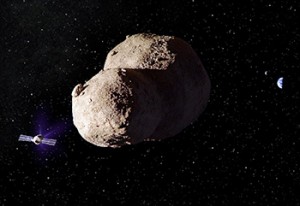 Over the weekend, I posted about asteroid 2012 DA14, which is not the threat some people are claiming it is (at least not right away). And now I have to tell you about an asteroid that might be a threat in the year 2040. Most likely it won't be, but it's something we need to look at carefully.
Over the weekend, I posted about asteroid 2012 DA14, which is not the threat some people are claiming it is (at least not right away). And now I have to tell you about an asteroid that might be a threat in the year 2040. Most likely it won't be, but it's something we need to look at carefully.
There's some background I have to give you so this all makes sense, but let me sum up here: the odds of an impact from asteroid 2011 AG5 are low, but not easily dismissed. If it passes us at just the right distance in 2023, it'll swing back again and impact the Earth in 2040. We don't know the orbit of it well enough to say either way just yet, and it may be late 2013 before we can be sure. An asteroid expert at NASA says waiting until next year for more observations is not a problem, but another asteroid expert is saying that waiting that long is a bad idea: we should start analyzing a possible deflection campaign for this rock now. I'm personally leaning toward the idea that getting moving on the initial analysis now is not such a bad idea. If you prefer, I have a list of bullet points at the conclusion of this post with summarized information.
[In the interest of full disclosure: Below, I will be talking about Rusty Schweickart and Don Yeomans. I've known Rusty for several years, and Don and I will be on a panel together talking about asteroid impacts at SXSW next week. I honestly like both Rusty and Don. They're good men, very intelligent and honest, and I have a lot of respect for both of them.
Also, because of the length and nature of this post, I strongly urge everyone to read the whole thing, carefully, before commenting. Thank you.]
The rock
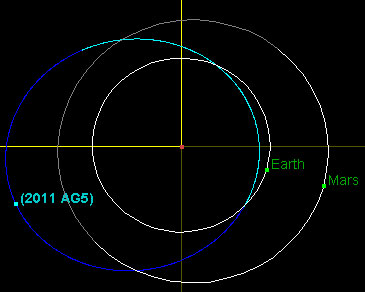 The asteroid, called 2011 AG5, was discovered in early 2011 by a telescopic survey of the sky designed to look for asteroids that can get near the Earth. Although its exact size is unknown, it's roughly 140 meters across -- the size of a football stadium. As you can see from this diagram, it orbits the Sun on an elliptical path that brings it out past the orbit of Mars and inside the orbit of Earth. It circles the Sun once every 1.7 years.
The asteroid, called 2011 AG5, was discovered in early 2011 by a telescopic survey of the sky designed to look for asteroids that can get near the Earth. Although its exact size is unknown, it's roughly 140 meters across -- the size of a football stadium. As you can see from this diagram, it orbits the Sun on an elliptical path that brings it out past the orbit of Mars and inside the orbit of Earth. It circles the Sun once every 1.7 years.
As it happens, the orbit of AG5 brings it close to Earth every few orbits. In 2023, it will pass us at a distance of about 1.6 million km (1 million miles). That's a safe distance, with no chance of it hitting us at all. However, you have to appreciate the gravity of this upcoming situation.
The keyhole
When AG5 passes us in February 2023, the Earth's gravity will bend its orbit a little bit, changing the path the rock takes. If it passes close to the Earth the orbit changes a lot; if it's too far the orbit changes only a little. But if AG5 passes us at just the right distance, the orbit will change just the right amount to put it on a collision course with Earth. This region of space is called a "keyhole", and in this case, should AG5 slip through it, it will hit us 17 years later, in 2040. That collision, though not global in scope, would be catastrophic: equal to about a 100 megaton explosion, twice that of the largest nuclear weapon ever detonated.
The problem is, we don't know the orbit of AG5 well enough to know if it will travel through the keyhole or not. As I pointed out in the article about the asteroid 2012 DA14, it can be tricky to try to predict asteroid orbits too far into the future. The orbit of an asteroid is determined by making measurements of its position over time, and because of various effects (like blurring due to our atmosphere) it is impossible to get exactly precise positions. They can be good enough to get an accurate orbit for the next few years, but the farther into the future you look, the fuzzier that path gets.
In the case of AG5 we know its orbit well enough to know for sure it'll miss us by a million miles in 2023, but we don't have the accuracy yet to know if it will thread the eye of this keyhole, which is very roughly 360 km (240 miles) across. It's like standing by the side of a road and knowing a car driving down it will safely miss you by 10 meters, but you can't be sure if that exact distance will be 10.004 meters or 9.996 meters. And that's the sort of accuracy we need for AG5.
The odds
At the moment, given the observations we have, the odds of AG5 passing through the keyhole in 2023 are about 1 in 625. For an asteroid impact, that's actually pretty high as these things go, but still pretty low in realistic terms. Let me be clear: any professional poker player will tell you never to bet on an inside straight, and the odds of getting the card you need in that case are only 1 in 13 or so. The odds of AG5 hitting us are much lower than that!
Moreover, since the orbit of the asteroid is uncertain, as we get better observations the predicted path is likely to change, to move. In that case -- which is almost certainly the way things will play out -- the predicted orbit will move away from the keyhole and we'll be safe from a 2040 impact. This sort of thing has happened several times before with asteroids as their positions are observed over time, and the orbital paths clarified.
Still, a 1 in 625 chance is high enough that we need to be sure. So how do we do that?
The mission
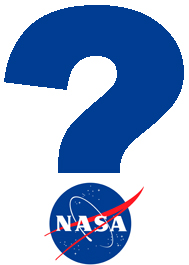 As you can see from the diagram at the top of the page, right now AG5 is on the other side of the Sun from us, which means it's up during the day and impossible to observe. Due to the way the Earth and AG5 orbit the Sun, it was able to be observed in January 2011, but it won't be visible to us again until September 2013 or so. In other words, we can't see it at all for another 18 months.
As you can see from the diagram at the top of the page, right now AG5 is on the other side of the Sun from us, which means it's up during the day and impossible to observe. Due to the way the Earth and AG5 orbit the Sun, it was able to be observed in January 2011, but it won't be visible to us again until September 2013 or so. In other words, we can't see it at all for another 18 months.
And this is where the story gets interesting.
Don Yeomans, a NASA expert on asteroid detection and orbital prediction, says waiting until the September 2013 observing window is not a problem. On a NASA page about AG5, he said:
It will be an opportunity to observe this space rock and further refine its orbit. Because of the extreme rarity of an impact by a near-Earth asteroid of this size, I fully expect we will be able to significantly reduce or rule out entirely any impact probability for the foreseeable future.
To be clear, this is true. In 2013, more observations can be made, the orbit measurements will be refined, and we'll probably see that AG5 will miss.
However, while true, Rusty Schweickart doesn't think that's enough. He's a former Apollo astronaut (he flew on Apollo 9) and has been spending the past few years studying the near-Earth asteroid threat in detail. He is part of the B612 Foundation, a group of scientists, engineers, and astronauts who are looking into this threat -- trying to determine the best course of action to find, characterize, and (should it be needed) deflect any incoming asteroid.
Schweickart thinks that waiting that long before taking any action is a mistake. If the asteroid is found to be on a path to miss the keyhole, then fine. But if the observations indicate a keyhole pass is likely, we'll have wasted 18 months that could have been spent looking into the planning of a deflection mission. And given the non-zero odds of such a pass, he thinks that planning should get started now.
The letter
He feels strongly enough about this that he wrote an open letter (PDF) to the NASA Chief Administrator Charles Bolden, himself a former astronaut. In this letter, he urges NASA to start looking into a pair of missions that can not only deflect the asteroid should it be found to be a significant impact threat, but can also carefully observe it in situ to make sure that the asteroid is moved onto a path that keeps it safely away from Earth.
Schweickart's idea is that a mission to deflect the asteroid needs two parts: 1) what's called a kinetic impactor, to ram the asteroid at high speed and push it into a different, safe orbit, and 2) an observer spacecraft that is placed into position near the asteroid at an earlier time, to carefully measure the asteroid's position and report back on the effectiveness of the impactor. What he is asking for in his open letter is not that this mission be built, just that NASA start looking into what would be needed to design it should AG5 prove to have better odds of being a threat.
As Schweickart told me in a phone conversation, observations from the ground after a deflecting impact from a spacecraft will not be sufficient to determine if the asteroid is on a safe orbit or not. Therefore, including an observer spacecraft is critical.
There's an added benefit too: the observer can be outfitted in such a way that should the impactor not get the whole job done, the observer might be put to use. While the mass of the observer spacecraft is small, it still has gravity. If it is equipped with low-thrust ion engines (which have been used in such spacecraft as Dawn and Deep Space 1), its feeble gravity can be used to very slowly alter the asteroid's orbit, in much the same way Earth's much stronger gravity can bend the path of the asteroid (see the illustration at the top of this post). Using the observer as a "gravity tractor" takes a lot of time -- years, certainly -- so again, the sooner something gets done the better.
The reaction
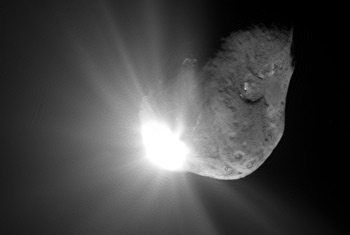 NASA's reaction to this has yet to be seen. However, this was not Schweickart's first letter to NASA: a few months ago he sent an initial letter to NASA about the asteroid, asking them to immediately begin a mission analysis. The answer he got was interesting. Basically, the argument was that the delay until September 2013 is warranted, because NASA has experience with a mission like this: the Deep Impact spacecraft was sent to comet Tempel 1 back in 2005. Deep Impact was equipped with a block of copper that was released and slammed into the comet, while the main spacecraft observed the impact from a distance. The experience gained from this mission means that a new mission for AG5 already has a precedent.
NASA's reaction to this has yet to be seen. However, this was not Schweickart's first letter to NASA: a few months ago he sent an initial letter to NASA about the asteroid, asking them to immediately begin a mission analysis. The answer he got was interesting. Basically, the argument was that the delay until September 2013 is warranted, because NASA has experience with a mission like this: the Deep Impact spacecraft was sent to comet Tempel 1 back in 2005. Deep Impact was equipped with a block of copper that was released and slammed into the comet, while the main spacecraft observed the impact from a distance. The experience gained from this mission means that a new mission for AG5 already has a precedent.
It was this reaction by NASA that prompted Schweickart to send his second letter. He argues that the Deep Impact mission analogy is not a good one for AG5. For one thing, Deep Impact was an all-in-one mission, with an observer and impactor on board one spacecraft. A campaign to deflect AG5 will require two separate spacecraft, and two launches (to make sure the observer is in place before the impactor's job gets done). Moreover, Tempel 1 is 1800 times bigger than AG5, which made it a much easier target to hit. Not only that, a kinetic impactor to move AG5 would have to hit at a much higher speed than the Deep Impact probe did (13.7 km/sec versus 10.3 for DI). And not only that, but the mass of the AG5 impactor will have to be much larger than what was used for Deep Impact -- the DI mission wasn't meant to deflect an comet, only to hit it and excavate a crater. To significantly deflect even a smaller rock means using a much heavier bullet.
The best time to deflect an asteroid is before it enters the keyhole. The keyhole is 360 kilometers across, so only a relatively small change in the asteroid's path is needed to miss it. But once AG5 passes through the keyhole (if it does), then it has to miss the entire Earth! Instead of it missing a target 360 km across, it has to miss a planet 13,000 km across. That usually requires a much larger change in velocity. Either way, hitting it earlier is better.
Schweickart also points out that the size of the asteroid is not really known. All we have is an estimate based on its brightness and distance. If it's even 30% wider than we think that means its mass increases by a factor of 2. That in turn means moving it is twice as hard.
Because of these difficulties, Schweickart is convinced mission planning needs to start now. He got a preliminary report from a European group called Deimos which investigated what missions might be possible to deflect AG5. According to that report, missions to AG5 are very difficult with existing launch vehicles (though easier if SpaceX gets its proposed Falcon Heavy rocket flying soon), and timing is a serious issue.
Deep Impact, Part 2?
And this is where things get sticky. The Deimos report is not an actual mission analysis plan, more like an outline of why we need to do one. It's very interesting and a good motivator, but not necessarily enough to get NASA moving on this. Many of the arguments presented by Schweickart have been countered by NASA as well.
For example, Schweickart and Deimos assumed a change in the velocity of the asteroid of 2 cm/sec is needed. However, in some cases that may be an overestimate. To miss the keyhole, the rock's velocity need only be changed by a fraction of a centimeter per second, if the spacecraft kinetic impact were to occur a year or two before the keyhole pass. After the keyhole pass, yes, a larger velocity is needed because the Earth is a larger target, as described above.
That small change in velocity could be performed much more easily, with some time to spare. It's even possible it could be done with a Deep Impact type spacecraft, which we know worked.
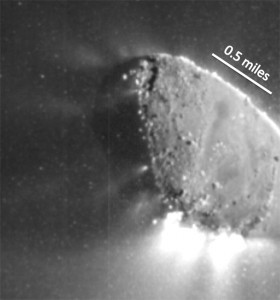 Schweickart points out the difficulties with this type of mission (speed and size of the target, as well as lighting on the Deep Impact mission being better than what an AG5 impact would have to deal with). However, there are some things that would be easier for an AG5 kinetic impactor than for the original Deep Impact comet mission. Comets are surrounded by material sublimating (turning from a solid to a gas) from the surface. That fog makes "terminal guidance" -- last minute steering -- difficult. But the asteroid AG5 won't have that. Also, that material pushes on the comet, making its orbit difficult to determine months in advance, making a rendezvous harder. Again, AG5 won't have that, which should make getting there somewhat easier.
Schweickart points out the difficulties with this type of mission (speed and size of the target, as well as lighting on the Deep Impact mission being better than what an AG5 impact would have to deal with). However, there are some things that would be easier for an AG5 kinetic impactor than for the original Deep Impact comet mission. Comets are surrounded by material sublimating (turning from a solid to a gas) from the surface. That fog makes "terminal guidance" -- last minute steering -- difficult. But the asteroid AG5 won't have that. Also, that material pushes on the comet, making its orbit difficult to determine months in advance, making a rendezvous harder. Again, AG5 won't have that, which should make getting there somewhat easier.
Yeomans also argues against the need of an observer spacecraft, saying ground-based observing should be able to tell whether or not the kinetic impactor worked or not. Schweickart strongly disagrees, claiming that the observer craft is critical as well to make sure (and also to use as a gravity tug). I honestly do not have enough information to be able to say who is correct in this case.
Clearly, there's a lot of back-and-forth here. When all is said and done, the argument really boils down to two things: should we be looking into a mission right now, and if we do, what kind should it be? In a nutshell, Yeomans thinks we can wait until after the September 2013 observations to see if we need to think about a mission, and Schweickart thinks we should be planning it now.
When phrased this way, I lean toward looking into a mission (and then if we need one, what kind to do based on what's found in the analysis). That way if the time comes and we need it, we're that far ahead of the game. It doesn't cost much: we're not talking about cutting metal for a spacecraft, or even designing one. All Schweickart wants is for NASA to do the launch and mission analysis. And while it seems likely that AG5 will miss the keyhole, why take the chance when the stakes are so large, and the effort so little? Better safe than sorry.
Conclusion
In case anyone scrolls past all that stuff above and just wants to get the bullet points, then here you go:
- Asteroid 2011 AG5 is a 140 meter wide rock that will pass a million miles from Earth in 2023. If it passes at just the right distance -- through what's called a keyhole -- the Earth's gravity will bend the orbit of the rock just the right amount to put it on an impact course for 2040.
- The odds of AG5 going through the keyhole are right now measured to be about 1 in 625. Further observations should refine its orbit, and from experience and physics, most astronomers think those odds will drop to 0.
- However, we cannot be sure that will be the case, and the current odds, while low, are still high enough to take seriously. The problem: due to the orbit of the asteroid, more observations won't be possible until September 2013. Waiting that long means delaying any potential space mission to deflect AG5.
- A campaign to deflect the asteroid optimally uses (at least) two missions: one which arrives at the asteroid first to observe, and a second to slam into the asteroid as hard as possible, in an attempt to change its course. According to Rusty Schweickart, the observer spacecraft is critical to make sure the impact did its job, and can also be used if needed to finesse the asteroid into a safe orbit.
- Such a campaign can be planned -- launch windows determined, spacecraft impactors modeled, and so on -- relatively quickly and cheaply. Schweickart is imploring NASA to start an analysis immediately. No actual mission needs to be proposed as yet, but should September 2013 followup observations of AG5 not eliminate the possibility of impact, then starting a campaign analysis now means we're that much readier should the time come.
- A call to action by Schweickart in an initial letter to NASA was declined. Officials there said the Deep Impact mission gave them the experience needed to put together a mission should AG5 prove to be a real threat. Schweickart wrote a second letter, saying this was not the case; a campaign to deflect AG5 is more complicated and more difficult, and analysis should begin now.
- The decision is now in NASA's hands.
Let me be very clear: Rusty Schweickart is not some crackpot; he is an accomplished astronaut and even served as Co-Chair of the NASA Advisory Council Ad-Hoc Task Force on Planetary Defense. Nor do I think Don Yeomans and NASA are simply dismissing his case out of hand; they have obviously given this quite a bit of thought and believe their case that waiting for more observations is sufficient.
Who's right?
In my personal opinion, it's very likely that NASA is correct that observations to be made late next year will refine the orbit of the asteroid, and we'll find it will miss.
However, Schweickart appears to be correct that there is no reason for NASA not to analyze the AG5 case in more detail. If AG5 turns out not to be a threat, no harm done.
And if it does turn out to be on a collision course with Earth, then perhaps much harm prevented.
Image credits: Dan Durda; NASA; Wikipedia
Â
Related Posts:
- No, asteroid 2012 DA14 will not hit us next year - Followup: Deep Impact crater on Tempel 1 - Debunking Doomsday - My asteroid impact talk is now on TED!
Â


























